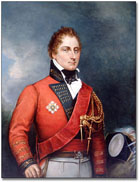Lieutenant General Sir Gordon Drummond
Sir Gordon Drummond was born September 27, 1772 in Quebec City, Canada and died on October 10, 1854 in London, England. He was a British Army Officer during the War of 1812.
 |
| NAME |
| Drummond, Gordon |
| BORN |
| September 27, 1772 Quebec City, Canada |
| DIED |
| October 10, 1854 London, England |
| ARMY |
| British |
| RANKS |
| Ens., Lt., Capt., Maj., Lt. Col. Col., Brig. Gen., Maj. Gen. |
Drummond was the youngest son of Colin Drummond of Perthshire and Catherine Oliphant of Rossie, in Scotland. He was educated in England. In 1789, he entered the British army as an ensign in the First Regiment of Foot. His rise up the ranks was rapid: lieutenant in the 41st Foot in March 1791, a captain in January 1792, a major in the 8th (King's) Foot in February 1794, and "junior lieutenant colonel" in March 1794. In that year, he first saw active service in the Netherlands campaign under the duke of York. He became colonel on January 1, 1798, a brigadier general in 1804, and a major general the following year.
Drummond rose rapidly through the military ranks after having joined the First Regiment of Foot, The Royal Scots. He served as a junior lieutenant colonel under the Duke of York in the Netherlands in 1794 and rose to major general by 1805. He married Margeret Russell of Brancepeth castle, and they had 3 children, 2 of them born in Canada.
Before coming to North America, he served in the Mediterranean and the West Indies. In July 1808, he arrived in Quebec City to serve under the governor, Sir James Craig. He was promoted to the rank of lieutenant general in June 1811, at which time he was commander of the forces in Canada. He left in October to to take up an appointment in Ireland. He returned to Canada in 1813 in order to succeed Maj. Gen. Francis De Rottenburg as commander of the forces in and administrator of Upper Canada.
Drummond had the distinction of being the first Canadian-born officer to take command in both the army and in the civil government when he became administrator of Upper Canada late in 1813. He was the fourth administrator of Ontario since the outbreak of war, having taken over from Brig. Gen. Roger Sheaffe's successor, Maj. Gen. Francis Baron de Rottenburg. By that time, Drummond's long service in the army had earned him the reputation of a talented officer with a natural eagerness tempered by sound judgment.
Drummond proved to be just the sort of determined commander that Maj. Gen. Sir George Prevost had been looking for. One of his first actions was to halt the flow of forces toward Lower Canada in order to maintain a strong presence in Upper Canada. Recognizing the importance of the Niagara region, he followed up the recent reacquisition of Fort George with a surprise attack on Fort Niagara in December of 1813. With this move, he gained control of the mouth of the Niagara River establishing a position that would work favourably for the British Army in the summer that followed.
As a civil administrator of Upper Canada, Drummond was harsh on traitors but respectful of the general population, despite having to impose martial law to obtain from them the food to feed his army. He presided over one session of the Upper Canadian assembly, which passed additional laws to support the war effort, including strong measures against traitors. Another problem he inherited was food shortages and the refusal of some farmers to sell supplies to the army. Like his predecessor, he was forced to impose martial law to meet the army's needs, but he stressed that it was to be applied carefully and mildly.
Taking Prevost to task on his word of making defensive measures paramount, Drummond demanded supplies to build new fortifications and reinforce existing ones. He also pressured Prevost for as many reinforcements as possible. But Drummond was also open to pressuring the U.S. by means of the occasional surprise raid.
In July 1814, he moved up from York to support Maj. Gen. Phineas Riall at Fort George in the weeks following the British defeat at Chippawa. Drummond arrived at the fort on July 25, and marched his troops, which included the Royal Scots and the King's, forward to join Riall's advance forces near Chippawa. Drummond arrived just as Riall was preparing a retreat from Brig. Gen. Winfield Scott's battalions. Drummond ordered an immediate attack and the small skirmish soon blossomed into a full-scale battle along a road called Lundy's Lane. Despite a serious wound as a result of being shot through the neck, Drummond continued to direct this bloodiest of battles until its stalemate finale.
Drummond spent the weeks following Lundy's Lane laying siege to Fort Erie where the Americans had sought refuge. With the siege dragging on, Drummond devised a risky and complicated plan to storm the fort at night. This disastrous offensive ended with the loss of hundreds of British men when the fort's magazine exploded under them. The siege was unsuccessful, but the Americans finally withdrew due to their own food shortages. Drummond then secured the area until winter once again put an end to campaigning. The Americans did not return.
After the war, in April 1815, Drummond was sworn in as administrator of Lower Canada, replacing George Prevost who had been recalled to England, and commander of the troops. He supervised the transition to peace between the Canada and the United States under the Treaty of Ghent.
Drummond returned to Britain in May 1816. He remained in the army as a peacetime soldier and did not see any more combat in his lifetime. In May 1825, he was promoted to a full-general. Drummond became a senior general in the British Army before dying in 1854.
 are available from Amazon.com
are available from Amazon.com

